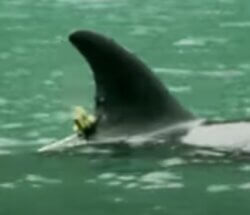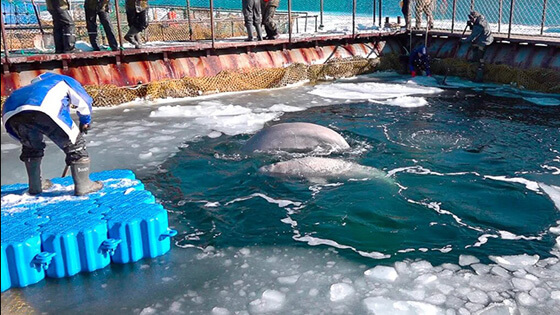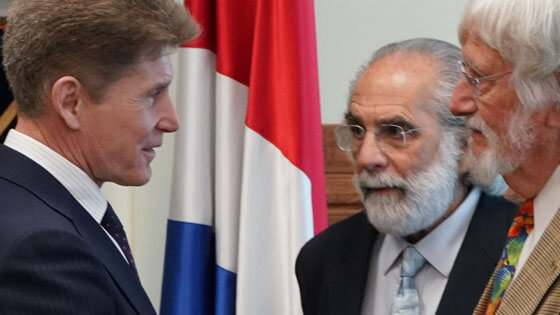It was the largest whale rescue program in history. Organized by the Whale Sanctuary Project in 2019 as one of our Whale Aid programs, it led to the release of 97 orcas and beluga whales who were being held in pens on Russia’s far east coast pending sale and transfer to marine entertainment parks in China.
Three years later, what a pleasure it is to see Zina, one of the orcas from that infamous “whale jail”, swimming confidently in the Sea of Okhotsk with a full pod of other orcas.
This video clip, excerpted from the new BBC nature series “Frozen Planet II” and narrated by David Attenborough, was captured by members of a film crew off the east coast of Russia. While filming an orca pod, they suddenly notice that one of the whales is sporting a satellite tag at the base of her dorsal fin. Could this really be one of the whales from the Whale Aid Russia rescue?

Zina is sporting a satellite tag at the base of her dorsal fin.
Yes, the tag indicates that she is indeed one of them. And Grigory Tsidulko, a member of the film crew who was also a member of our Whale Aid team, notes that visual identifiers on her body are a clear match to a photo of Zina that was taken at the “whale jail” (as Russian media first dubbed the facility).
What we cannot know for sure is whether the pod is her original family or if she’s been adopted by a new one. Either way, she is clearly integrated with the family, and everyone who was involved in this remarkable rescue effort will have their hearts jumping for joy to see this.
More about Zina and the other whales in a moment. But first, a brief cautionary note on the commentary in this video clip:
These 97 whales were excellent candidates for being returned to the open ocean because they had spent their formative years growing up with their families and had only been in captivity for a period of months. The situation is very different for whales who were born in concrete tanks or have lived most of their lives in captivity, and have not grown up in a natural family, nor even learned how to care for themselves. They cannot – as is suggested in the video – be released into the open ocean. The right solution for them is to be transferred to sanctuaries, where they can enjoy a life that’s close to nature while still receiving human care.
More about Whale Aid Russia – the biggest whale rescue in history
The full story of Whale Aid Russia is told here. It goes roughly as follows:

Whales at the whale jail were beginning to suffer from frostbite.
In November 2018, the Russian media became aware of a largely secret operation being conducted in a quiet area of the country’s Far East coast known as Srednyaya Bay, about 115 miles north of Vladivostok. The compound included a series of small, netted enclosures containing more than 100 orcas and beluga whales. The pens were already starting to freeze over and the beluga whales were beginning to show signs of frostbite.
As news of this “whale jail” began to spread through the Russian media and, in turn, the international media, vigorous protests erupted at home and abroad. A network of Russian animal protection groups launched a petition that quickly garnered hundreds of thousands of signatures. Letters of protest poured into the Kremlin.
As soon as the Whale Sanctuary Project learned about the whale jail, our executive director Charles Vinick, Jean-Michel Cousteau of Ocean Futures Society, David Phillips of Earth Island Institute, and Roger Payne of Ocean Alliance wrote to President Putin, offering our collective assistance in assessing the condition of the whales with a view to helping return them to the ocean.

Governor Oleg Kozhemyako (left) with Charles Vinick and Jean-Michel Cousteau.
Our team was then invited to Russia, initially by Oleg Kozhemyako Governor of Primorsky Territory, where the whales were being held. Subsequently the federal government issued visas to the team to come to Moscow and meet with the Department of Natural Resources & the Environment and other agencies to determine what could be done for the whales.
After those meetings, we traveled to Vladivostok, on Russia’s Far East coast, where Gov. Kozhemyako, introduced us to his team so that we could assess the welfare of the whales during our visit to Srednyaya Bay, where the whale jail was located.
We reported that we had identified no scientific reasons why animals at the whale jail could not be rehabilitated and released.Following the visit, we provided a detailed report to the Russian government, concluding that “we have not identified any scientific reasons why any individual animals cannot be rehabilitated and released.”
Shortly after this, and in consultation with our Whale Aid team, the government began a rehabilitation program in preparation for the whales to be returned to the region of the Sea of Okhotsk, from where they had been captured.

President Putin announces the return of the first whales to their ocean home.
On June 20th, 2019, President Putin announced on Russian TV that the first group of orcas and belugas had just begun their journey back to the ocean. Deputy Prime Minister Alexei Gordeyev added that the government also intended to clamp down on the capture of whales.
And on November 10th, the Russian Research Institute of Fisheries & Oceanography reported that it had carried out the release of the last 31 whales.
The rescue and release of 97 captive whales was a remarkable and historic achievement, in which many people played a key role, including:
- The Russian activists who brought the plight of these whales to the world’s attention and maintained steady pressure for their release;
- The expert members of the international team assembled by the Whale Sanctuary Project to assess the health of the whales in their sea pens and recommend protocols for their release;
- The Russian scientists whose expertise was critically important to the releases;
- Our Executive Director Charles Vinick, who steered the whole Whale Aid Russia operation;
- Jean-Michel Cousteau, who opened doors to the highest levels of the government;
- And the generous supporters of the Whale Sanctuary Project, without whom none of this would have been possible.
Check out the full story of Whale Aid Russia on the Whale Sanctuary Project website here.